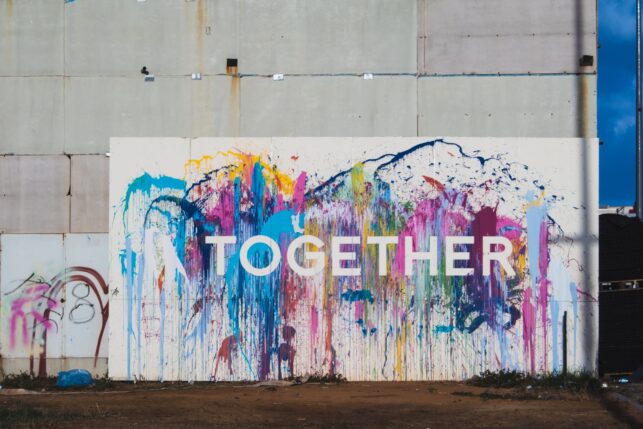Improve morale.
Complement strengths.
Build trust.
Team development
Learn to harness diversity and individual styles whether you’re new or an experienced manager. Understand how to manage a high performing team by improving productivity and humility.
Exploring teams in conflict
If you’ve inherited a team that’s disconnected or the team dynamic has changed this skill set will equip you to communicate openly and lead constructively through the disharmony.
Individual commitment to a group effort–that is what makes a teamwork, a company work, a society work, a civilization work.
Vince Lombardi


What is teamwork?
There’s no “I” in the team that’s what they say and yet an individual’s contribution is key. When we have a clear vision, defined roles and responsibilities, trusted collaboration and accountability, all working towards the same goal, then a group becomes a team.
Throughout my career I’ve been very fortunate to have been involved in some fantastic teams, but there were also some dysfunctional ones and some groups of professionals who will never make it as a team. Have you ever joined a team and felt like you don’t fit? Have you ever left a team and the team has failed? Maybe you just don’t like being part of a team and prefer to sit on the outside looking in, make your contribution when it matters and then step away. Perhaps your team was working brilliantly until a new member joined and now things aren’t so great?
Whatever your role or experiences, we all have felt that sense of harmony when we’ve led or worked in a team that’s been productive. We also know how it feels to work in teams where there’s no harmony. Many team experts can demonstrate research, assessment tools and practical activities that give us evidence of why a team dynamic doesn’t work or suit the individual. It comes down to competence, leadership, individual attitudes and behaviours.
Teamwork Competencies
What are the most tried and tested competencies of effective teamwork? Well one of the most successful teams I was proud to be part of was when I worked as a consultant helping a call centre with its high call volume. A decision was made to extend the team by outsourcing a percentage of the work to a third-party organisation. When the existing team heard the news, they got worried about their job security. As a consequence, morale and productivity plummeted.
When a clear, trustworthy and empathetic leadership was in place the team began to settle… A well thought out plan with clear expectations was communicated and the team set to work.
Team analysis based on Belbin
In order to allocate roles and responsibilities, we assessed this team’s Belbin team roles© and realised why this team were effective and why they gelled so well. Meredith Belbin© describes the ideal team dynamic as “being made up of eligible and suitable profiles”. He explains in his work about natural clusters of behaviours that we all possess but use them differently depending on team culture, experience, and personality preference. In his 50+ years of research he has proven that suitability is just as important in a team as eligibility and his model is widely used in organisations for recruitment and team development. The team I was assisting had a perfectly balanced team through the Belbin© lens so once they knew why and where they were going (clear vision) they used this knowledge of themselves and each other to allocate projects and tasks.
Monitoring and regular review helped make this outsourcing project a huge success. As the on boarding of the third-party call centre team began, a code of conduct needed to be agreed by both teams to ensure skills were taught to help them hold each other to account through open and honest conversations. With dialogue and very clear expectations outlined by the leadership team, collaboration and high trust, the team felt safe to share ideas, talk about mistakes, and work on challenges together.
As I reflect on this team experience and the results I come to the conclusion that it was productive leadership, sound relationships, regular review of the team’s performance and a culture of high trust that successfully outsourced a profitable business in harmony – teamwork at its best!
How to build an effective team
A team can be built in a number of ways:
- it can grow naturally
- it can grow through a team building exercise or
- it can be taught with application of team theory.
If we regularly apply the 7 characteristics of highly effective teams and we do this with mutual respect and mutual purpose for each other, then a team becomes more effective than ever.
The 7 characteristics are:
- clear objectives
- trust and collaboration
- effective decision making
- clear roles and responsibilities
- sound relationships
- analysis and review of team performance
- wholehearted leadership
How does a team build naturally?
Bruce Tuckman© and his stages of team development say that when a group first comes together the relationships are ‘forming’. Team members are polite and eager to get going so they need clear direction. As the group progresses and gets to know each other the next stage is described as ‘storming’ where people share opinions and there’s often conflict, and relationships are at risk. Clarity of objectives and regular review by the leaders is required to keep the team on track. Once the conflict eases, the next stage of the team is ‘norming’ where agreements are made, and the relationship “norms” become habits. Often leaders step back and allow the team to grow in confidence and competence. The final stage is ‘performing’ where they understand what’s expected of themselves and each other and they carry out their roles and responsibilities effectively. This is where the leader sets challenges and leads at arm’s length. If the team dynamic changes because a team member leaves, or a new leader takes over, then the team can follow Tuckman’s© team process over again.
How does a team build through activity?
We often get enquiries from frustrated professionals who want to improve their team’s performance such as conflict amongst teams, objective setting and lack of accountability. In order to offer a return on investment we find ourselves as trainers and coaches troubleshooting to find the best team building event for them. As we explore what the end result will look like, we discuss how we want the team to feel, what we want them to see, and what we want them to do as a result of the training. We also think about what environment will bring us results and what type of activities are best suited to their company culture.
We know that blindfolded challenges and jumping from high ropes would suit some and classroom-based activities would suit others. But it doesn’t stop there, you’ve also got sport, art and socialising that help bring people together. Have you ever tried a team event on screen printing or learning how to do French braids? Because we have and it works!
How to apply team theory
There are a number of team gurus out there with tried and tested research. Myers Briggs©, Tuckman©, John Adair©, Meredith Belbin© are only a few that we mention here In our experience depending on company culture, the needs of the business and the need for nurturing creativity will help us decide on how and what to apply.
Theory doesn’t always have to be classroom based, our facilitators have found fun and simple ways to incorporate theory into practical activities. This means you’ll not only learn the techniques but you’re also more likely to do something with it.
Happy Team Building!
Increase your potential
Engage in our effective training program that is tailored to your business to get the best results.
Contact Us
